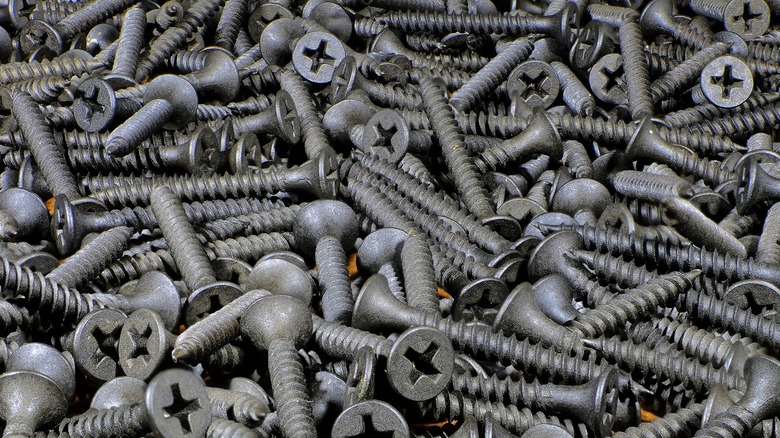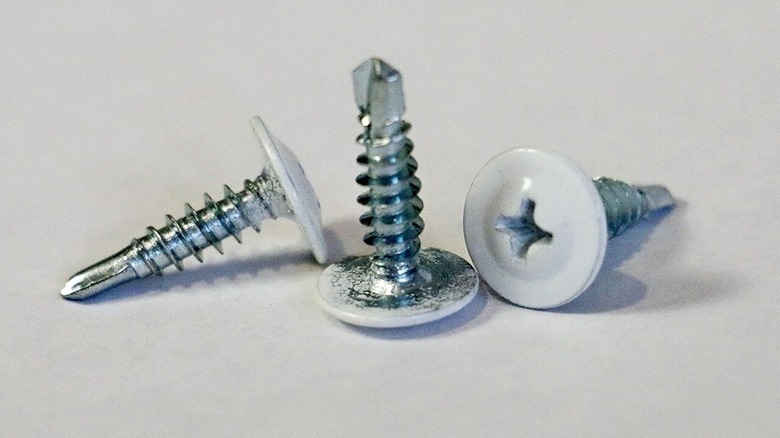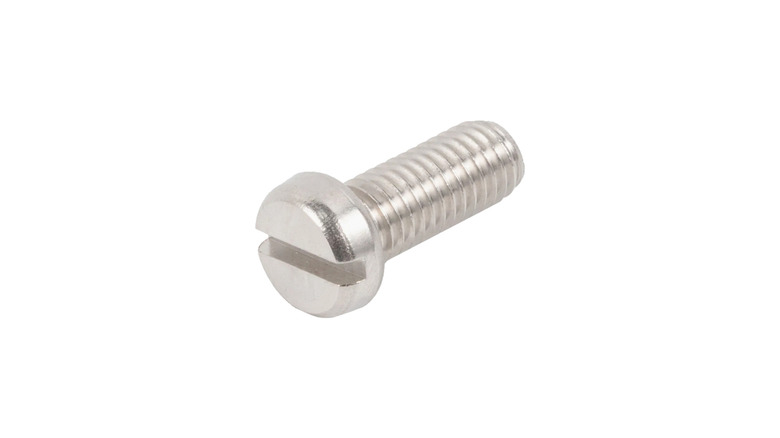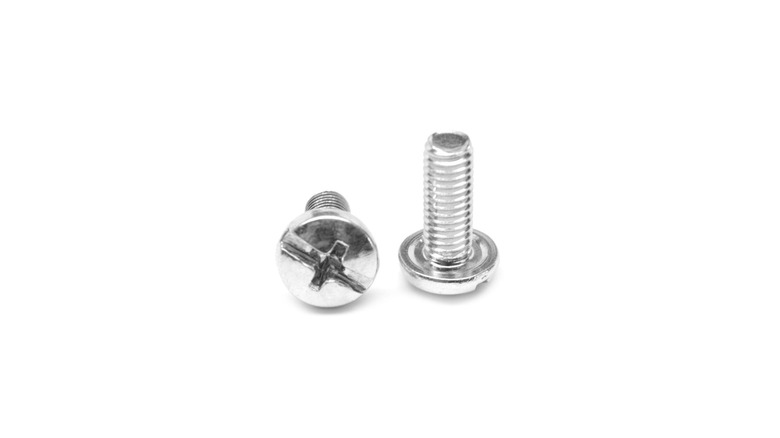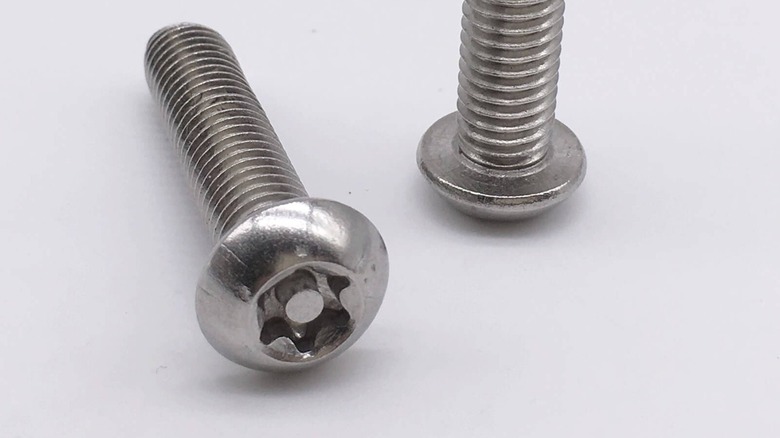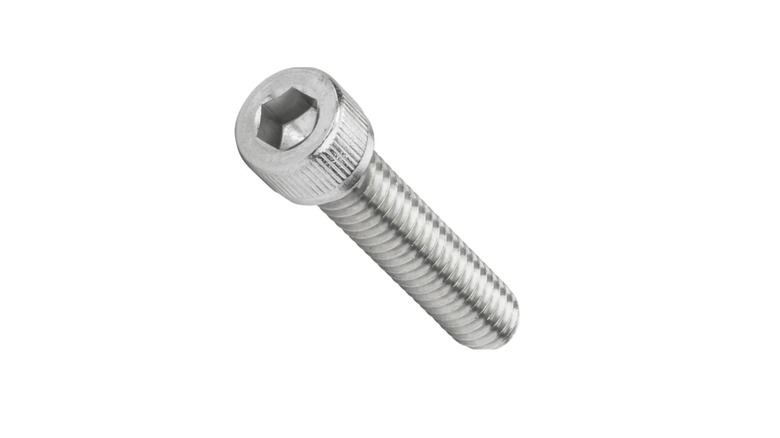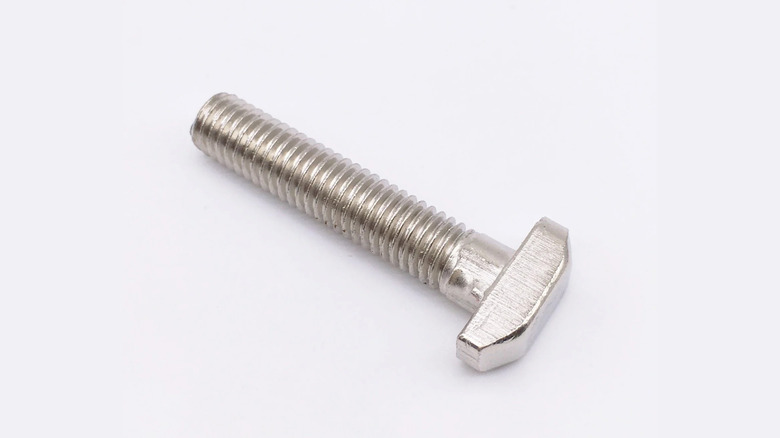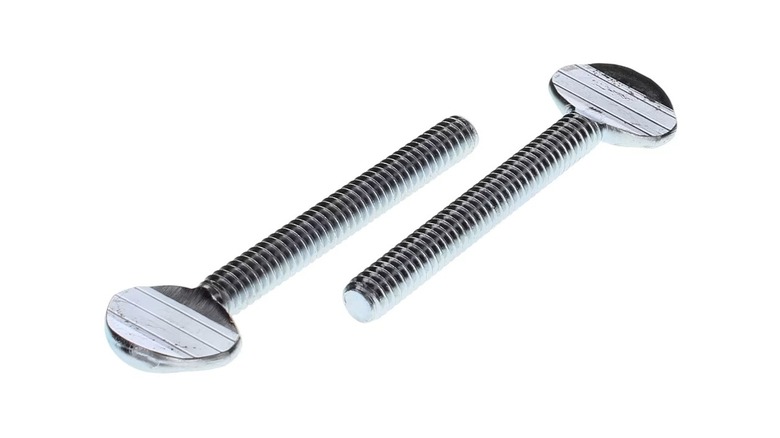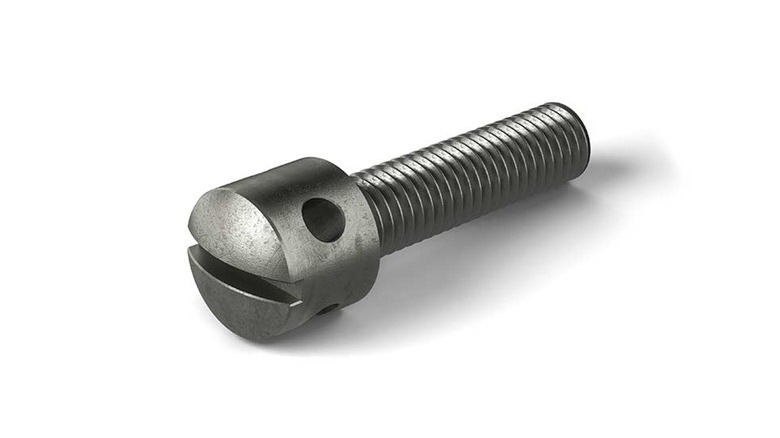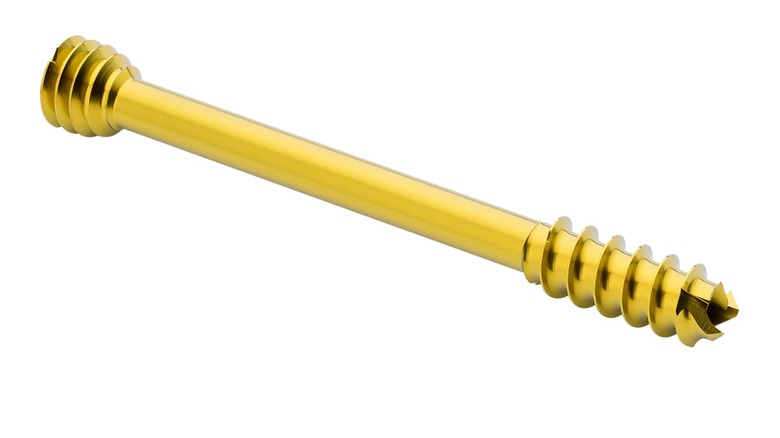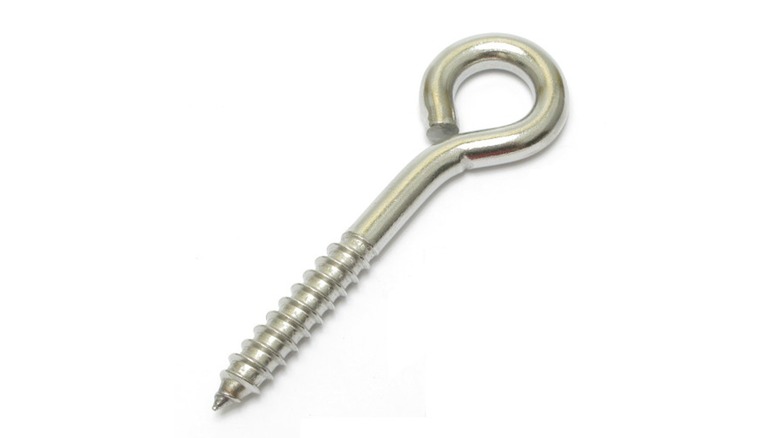12 Types Of Screw Heads And Drivers (And What They're Best Used For)
Screws may be commonplace, but that doesn't mean they're simple. A screw is any shaft with a corkscrew groove carved around its surface and, regardless of their design, screws are usually used to fasten or squeeze two or more objects together. It's unclear when the screw was first invented, but they show up in various forms and as part of cultures as far back as the 5th century B.C.
Since then, screws have evolved considerably, diversifying in both form and function. Most of the screws we're familiar with today are relatively recent inventions. In fact, the Phillips head screw is less than a century old, first appearing in the 1930s. In addition to having different widths and lengths, flat or pointed tips, you've probably noticed that screws come in a wide range of screw heads, as well.
You might assume that different the screw heads are purely a matter of aesthetic, but they're often designed for a specific purpose. While you might be able to get away with using any old screw for your home DIY projects, it's worth knowing about different types of common screw heads. We'll also talk about what they're used for, and the types of drivers you'll need to fasten and unfasten them.
Flat head screws
Despite being among the most common types of screws, there is some confusion about the nature of the flat head screw, based on some fuzzy nomenclature. Flat head screws share a common name with the flat head screwdriver, but that's something of a misnomer.
It's more accurate to call a flat head screwdriver a standard or slotted screwdriver, as it was the typical form before the invention of the Phillips screwdriver. Instead, the term flat head refers not to the shape of the driver or the drive slot, but to the geometry of the screw. A flat head screw is so called because it has a flat head.
Typically, flat head screws are flat on top and tapered underneath. When used with a countersink hole, the head of the screw sets into the material you're fastening, so that none of the head sticks above the surface once driven. Flat head screws are preferred when you want a clean, smooth finish. They're also safer, eliminating protruding heads that can catch onto clothing or other items. Typically, you can drive a flat head screw with a Phillips screwdriver, though they can be made to work with just about any type of driver.
Flange head screws
The primary feature which separates a flange head screw from its peers is the presence of a built-in washer under the screw head. Tips can either be pointed or flat at the ends, depending on their purpose. They are typically pointed if they're going into soft materials like wood or dry wall, and flat when used to bind two or more pieces of metal together.
All that really matters for classification as a flange head screw is whether or not there's a combined screw head and washer at the top. Flange head screws are preferable for jobs requiring secure fastening and a gentler touch. Washers work by creating a larger surface area, allowing you to spread tension forces over a wider space. They allow for secure holds while preventing damage to materials at the fastening point.
Flange head screws can be fastened and unfastened by a wide range of drivers, depending on the geometry of the head's surface. You can find them with slotted heads, Phillips, hex, and more. There are also flange head screws with no drive point indentation, intended for use with a wrench.
Binding head screws
Binding head screws are designed to facilitate easier fastening and unfastening, and come in a wide variety, with a diversity of diameters and lengths to fit all your needs. The defining feature is a widened and thickened head with a deeper driver groove. The deepened groove means they can handle more torque.
Binding head screws are similar to pan head screws, so named for the resemblance between the head and an upside down frying pan. Both offer a low profile head with rounded sides, which sits low against the material's surface once fastened. The rounded sides prevent any sharp corners or snagging edges in your finished project. Most importantly, the deeper drive recession allows pan head screws to accept higher torque forces. Binding head screws take it up a notch by providing an even deeper slot.
Depending on the shape of the drive recession, they can accept slotted screwdrivers, Phillips screwdrivers, hex drivers, and more. No matter the shape, they provide about 10% more surface area, allowing you to fasten them more tightly while reducing the risk of creating a stripped screw, which can be hard to remove. Depending on their purpose, some binding head screws also have channels cut into the bottom of the head, so you can run wires across the surface and bind them in place.
Combination head screws
Combination head screws are designed to accept, as the name suggests, a variety of screwdriver heads. If you have a good multi-bit screwdriver, you'll have plenty to choose from. While most screws will only accept a specific type of driver, combination head screws can be fastened by two or more different types. They're useful for big jobs where you might have multiple people with access to different tools. They are also common on applications that see a lot of action. Think drawer handles, door knobs, and hinges. These items tend to loosen over time through continued use, and require frequent tightening.
The standard version of a combination head screw is designed to accept standard and Phillips screwdrivers. They feature a long, thin channel spanning the diameter of the head, intersected by a shorter perpendicular channel. While those are the most common, you can find a variety of combinations, depending on your use case and the tools you have available.
With their hybrid design, combination head screws make it more likely that you'll be able to fasten and unfasten them, no matter what tools you happen to have in your tool box or junk drawer. It also reduces the amount of time and effort it takes to complete common jobs. All of that makes combination head screws some of the most popular models for everyday use.
Pin head security screws
These are a unique type of screw you may not have encountered or noticed before. In contrast to a typical screw, these have design features which make them impossible to fasten or unfasten without a specially designed driver. Some have ordinary driver recessions, like Phillips head, but with a pin sticking up at the center. You need a specialized driver with a recession of its own to accommodate the pin. Without it, you won't be able to turn the screw.
Other types of security screws feature unique recess designs, requiring a proprietary driver. Without that, a person can't fasten or unfasten them, and that's the whole point. Security screws are useful for public installations where you don't want just anyone being able to take things apart. Security screws come in different levels of security, with the most secure being custom builds that only you have access to.
Typically, you need to order custom screws in batches of at least several hundreds, accompanied by a driver with a completely unique shape to match your custom screws. You can get a single driver made, or if you're using screws for multiple jobs with a big team, you can get several, all with your bespoke security shape.
Allen head screws
Instead of a single long channel or a cross (the most common driver shapes), Allen head screws are characterized by a hex channel in the head. They are common in all sorts of things, including big box furniture, and can only be driven by a compatible Allen wrench, a key, or a hexagonal screwdriver bit. They are also found in more serious construction projects, like consumer electronics, heavy machinery, and spaceships. If you're having problems with your Allen head screws, make sure you're using your Allen wrench the right way, or get a good electric screwdriver and equip it with the right bit.
The use of a hex wrench or Allen key instead of a more typical screwdriver offers six contact points to distribute torque, meaning that Allen head screws can accept higher torque pressure and achieve tighter bonds. Since each screw makes better contact with the surface, you can use fewer of them, saving construction time and reducing the final weight of whatever you're building.
Allen head screws are also useful in tight spaces. Because an Allen key typically bends at a right angle, you can fasten and unfasten screws in spaces where an ordinary screwdriver wouldn't fit. Additionally, those keys are made in a wide range of materials, including high-strength materials like titanium, which is both lightweight and incredibly strong. They are often used in aerospace applications, owing to this combination of low weight, strength, and ease of use. In an industry where each pound added to the payload can massively increase costs, every little bit matters.
T-head screws
At a glance, T-head screws look almost like a miniature hammerhead, which is where they get their common name of hammerhead bolts. There's something delightful about a tool named for an animal that is itself named for a different tool. T-head screws have thick, bolt-like threaded bodies and a robust t-shaped head. You'll also notice there are no recesses on the surface that might accept a driver.
While you could use the t-shaped head to turn the screw by hand or with some good pliers (and if you don't have screw extraction pliers, you'll wish you had them sooner), that's not how they're intended to be used. Instead, the elongated head drops into a slot and locks into place. You can then tighten a nut from the other side and secure it in place. They are useful in high-stress construction environments because they evenly distribute force along a large surface area.
By slotting them into a channel right up front and then tightening them from beneath, you can ensure a secure hold with a flush finish. Moreover, T-head screws are resistant to loosening from vibrations or from heavy loads. Their strength and reliability makes them ideal for high-stress environments like the guide rails of elevators, building frames, and bridges.
Thumb screws
While these screws share a name with a historical torture device, they're actually designed to make your life easier and more comfortable. Thumb screws come in a wide variety of shapes and materials, but they all have one thing in common. As the name suggests, thumb screws have heads designed to be turned easily by hand.
The head surface of a thumb screw is often knurled, meaning its surface is full of grooves or ridges which improve your grip when rotating it. In some thumb screws, the heads are circular but lack a recession for a driver. Others have thin, wide heads you can turn by pinching them between your thumb and forefinger. They can be made out of plastic, metal, or a combination of the two, with a metal thread and a plastic head.
Thumb screws are limited in how much torque they can achieve. The unaided human hand just can't compete with specially engineered tools. And the head necessarily sticks out above the fastened surface, so that you have something to grab onto when you need to remove it. In spite of those limitations, thumb screws are useful for a wide range of applications. In particular, thumb screws are ideal for window locks, instrument panels, and other situations which require frequent loosening and tightening.
Raised countersunk head screws
Raised countersunk screws marry the features of a countersunk screw (the conical underside designed to settle into a countersink) and a thicker raised head. It might seem like something of a contradiction, because the countersink serves to lower the profile of the finished product, while the thicker head raises it back up, but the combination of the two is really useful in several circumstances. When working with wood, for example, it can help you to drive screws to a consistent depth across a project. It also reduces the risk of splitting or otherwise damaging the material, especially when used in conjunction with a pilot hole.
Raised countersunk head screws come with a variety of recess holes, with Phillips being the most common, so they can be fastened and unfastened with typical screwdrivers or drills. Once driven, most of the screw head sinks into the material, courtesy of the countersink hole, but a small curved top remains above the material. The deeper head provides a better gripping surface when fastening, allowing you to apply more torque. It's a compromise between hiding your hardware and getting a solid connection with the driver.
Capstan screws
Capstan head screws generally feature a thick body and a wide, deep-slotted head. They are designed to hold up to higher levels of torque, allowing you to achieve secure holds. They come with a variety of slot recessions, making them compatible with most screwdriver heads. That said, slotted and Phillips seem to be the most common kinds of recessions.
The most notable feature of capstan screws are the small horizontal holes drilled through the middle of the head. Those holes can be used after the screws are driven to hold locking pins or wires which keep the screw in place long-term. It makes them extra secure and prevents loosening over time. Those holes can also be used to turn the screw by inserting and turning a pin, like you'd do with the ship part that the capstan screw gets its name from.
You know that classic pirate movie scene, when the pirates are singing a sea shanty while pacing in a circle, turning a big wooden circle to pull up the ship's anchor? That circular contraption with its long wooden spokes is known as a capstan. By turning the attached spokes, the capstan increases the pulling force, making it easier to pull up ropes and other heavy objects. The capstan screw is based on the same philosophy, only much smaller.
Headless screws
Unless you're a solar-powered sea slug growing a new body, losing your head is something you generally want to avoid. However, headless screws have a lot going for them. In some contexts, headless screws are sometimes called grub screws or set screws. Regardless of their name, they have no head on top and rely instead on an internal drive mechanism recessed into the top of the body. Depending on its characteristics, a headless screw can be used in one of a variety of settings. Grub screws are typically short and threaded from one end to the other. They are useful in precision engineering when you want your fastener to disappear completely inside the fastened materials. Longer and more complicated headless screws are common in medical applications to stabilize broken bones, particularly at or near a joint.
In surgical applications, headless screws often have complicated surface features with varying thread widths or a long smooth gap between two completely different thread types. Typically, the threads at the leading end of the screw are farther apart and narrower, while the threads at the tail end are wider and closer together. This is an intentional design choice that helps to hold bones together. The narrow leading threads pass beyond the fracture and only grab on at the far fragment. Once there, the larger threads make the leading end advance more quickly than the trailing end, compressing the fragments together securely.
Eye head screw
Eye-head screws feature a head that is similar in profile to some thumb screws, but instead of a solid oval-shaped vertical head, these feature an open loop of metal. Small ones are often intended to be driven by hand, as there is no recession for accepting a screwdriver. Alternatively, they can be turned in a similar fashion to a capstan screw, by inserting a rod into the loop and twisting. Once fastened, that loop is used to hold wires and cables or to suspend hanging objects like planters or picture frames.
Larger eye-head screws used for big construction jobs and heavy machinery are typically tightened using a threaded bolt and wrench. These typically feature a threaded shaft known as the shank, a thick metal ring or loop, and a slightly widened shoulder, or "skirt," between the loop and shank.
These large eye-head screws are often used on big construction projects. They're placed around the perimeter to act as anchor points for lifting, pulling, or otherwise moving large objects. The widened shoulder between the shank and the loop creates a structure that prevents bending. If you're going to use those screw to lift something at an angle with a sling, you should use a shouldered eye-head screw.
